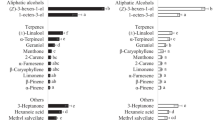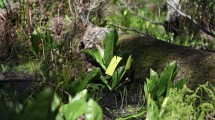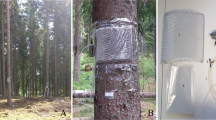Summary.
Feeding by Pieris brassicae or P. rapae caterpillars on Brussels sprouts plants induces the emission of synomones that attract natural enemies of the caterpillars, Cotesia glomerata, a generalist parasitoid, and C. rubecula, a specialist on P. rapae. Previous research on this tritrophic system has identified a large number of volatiles in the headspace of herbivore-damaged Brussels sprouts plants, and this paper addresses the question which of these volatiles are perceived by the two parasitoid species. Headspace odors from both P. brassicae- and P. rapae-damaged Brussels sprouts plants were analyzed by coupled gas chromatography electro- antennogram (GC-EAG) detection. Twenty volatiles evoked consistent EAG reactions in the antennae of both species and nineteen of these volatiles could be identified with GC-MS. One component that could not be identified due to its low concentration, evoked EAG responses in antennae of C. rubecula only. Possible consequences for searching behavior of the two parasitoid species are discussed.
Similar content being viewed by others
Author information
Authors and Affiliations
Additional information
Received 28 February 2002; accepted 27 May 2002.
Rights and permissions
About this article
Cite this article
Smid, H., van Loon, J., Posthumus, M. et al. GC-EAG-analysis of volatiles from Brussels sprouts plants damaged by two species of Pieris caterpillars: olfactory receptive range of a specialist and a generalist parasitoid wasp species. Chemoecology 12, 169–176 (2002). https://doi.org/10.1007/PL00012665
Issue Date:
DOI: https://doi.org/10.1007/PL00012665




